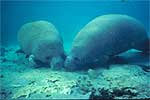 | Manatee Senses |
 | Manatee Senses |
|
By Ellen Kuwana Neuroscience for Kids Staff Writer April 28, 2003
The Hairy DetailsDr. Roger L. Reep and his colleagues at the University of Florida have been studying these amazing manatee hairs. They found that these gentle animals had approximately 1500 hairs on each side of their body (dorsal and ventral, or topside and underside) and that each hair was spaced far enough apart so as to be able to move around without touching another hair. Each hair is connected to 20-50 axons. This means that the each hair conveys information to many neurons. (By comparison, each hair on your arm is connected to approximately five neurons.) This suggests that the hair system must be very important to the manatees. The scientists theorize that the manatees use the hairs to get information about water currents and other animals in the water. This sensory system would be quite useful in gathering information in the dark waters where the animals have limited vision.
A Mystery Solved  Why,
despite laws requiring boats to slow down in Florida waters where manatees
live, are manatees still killed by speedboats?
Manatee deaths reached record highs in 2000 and 2001. Although manatees
can swim up to 6.4 meters per second, most of the time the animals swim
slowly. Why do they collide so often with boats? Why don't they swim away
from the boats? Why,
despite laws requiring boats to slow down in Florida waters where manatees
live, are manatees still killed by speedboats?
Manatee deaths reached record highs in 2000 and 2001. Although manatees
can swim up to 6.4 meters per second, most of the time the animals swim
slowly. Why do they collide so often with boats? Why don't they swim away
from the boats? To investigate this paradox, scientists analyzed captive manatees' sense of hearing. They found that manatees have good hearing abilities at high frequencies, but not at low frequencies. Manatees hear in a range of 400-46,000 hertz. The peak of sensitivity in this range appears to be 16,000-18,000 hertz. Unfortunately for the manatee, slow-moving boats create low frequency sounds. Most boats produce sounds around or below 1,000 hertz. These low-frequency sounds are difficult for the manatees to locate. Manatees have fused cervical vertebrae, which limits their neck mobility. This contributes to their difficulty in telling where sounds are coming from. So the laws requiring boats to slow down, which were meant to protect manatees, may actually make it more difficult for manatees to avoid colliding with boat engines...the manatees do not hear the boat propellers until it's too late! |
Did you know? |
|
|
References:
|
| GO TO: | Neuroscience In The News | Explore the Nervous System | Table of Contents |
![[email]](./gif/menue.gif) Send E-mail |
 Fill out survey |
 Get Newsletter |
 Search Pages |
 Take Notes |